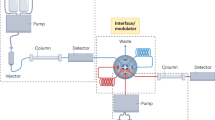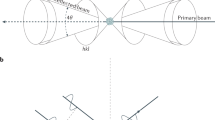Abstract
QUANTITATIVE estimation of peak areas on gas-liquid chromatograms has been carried out by a variety of methods, which include triangulation, cutting out the peak areas and weighing the cut paper, planimeter tracing and use of an integrator built into the recorder. A new method recently proposed by Bartlet and Smith1 is based on evidence that the peaks obtained with a well-designed chromatograph closely approximate a normal or Gaussian distribution curve.
This is a preview of subscription content, access via your institution
Access options
Subscribe to this journal
Receive 51 print issues and online access
$199.00 per year
only $3.90 per issue
Buy this article
- Purchase on Springer Link
- Instant access to full article PDF
Prices may be subject to local taxes which are calculated during checkout
Similar content being viewed by others
References
Bartlet, J. C., and Smith, D. M., Canad. J. Chem., 38, 2057 (1960).
Pecsok, R. L., Principles and Practise of Gas Chromatography, 145 (John Wiley and Sons, Inc., New York, 1959).
Author information
Authors and Affiliations
Rights and permissions
About this article
Cite this article
CARROLL, K. Quantitative Estimation of Peak Areas in Gas-Liquid Chromatography. Nature 191, 377–378 (1961). https://doi.org/10.1038/191377a0
Issue Date:
DOI: https://doi.org/10.1038/191377a0
This article is cited by
-
Analysis of whole cellular fatty acids and anastomosis relationships of binucleate Rhizoctonia spp. associated with Ceratobasidium cornigerum
Mycoscience (2005)
-
Acyl lipid metabolism in the oleaginous yeastRhodotorula gracilis (CBS 3043)
Lipids (1989)
-
Lipid composition and effect of amphotericin B on yeast cells of Paracoccidioides brasiliensis
Mycopathologia (1988)
-
A simplified approach to the analysis of subclasses of phospholipids: Application to human platelets
Lipids (1988)
-
The dietary regulation of acyltransferase and desaturase activities in microsomal membranes of rat liver
Lipids (1984)
Comments
By submitting a comment you agree to abide by our Terms and Community Guidelines. If you find something abusive or that does not comply with our terms or guidelines please flag it as inappropriate.



